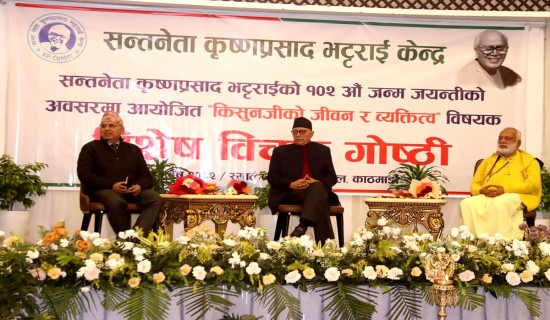- Tuesday, 23 December 2025
Awe-Inspiring Appearance Of Jupiter, Saturn
Dr. Rishi Shah
The night skies of this month would present avid sky-watchers awe-inspiring appearance of the mighty planets Jupiter and Saturn along with the spectacular sights of other celestial entities that would pepper all over the heavens.
The elusive planet Mercury would arrive at its greatest eastern elongation from the Sun on 27 August. It would climb highest above the western horizon in the evening sky.
It would be scooting through constellations Taurus (bull) and Virgo (maiden). However, perceiving it this month would not be easy from here. Planet Venus could be viewed vividly but briefly before sun-up in the south-eastern sky.
It would be cavorting with stars of constellations Taurus and Gemini (twins). The red planet Mars could be marveled at from midnight in the eastern sky till sun-up in the south-eastern sky.
It would be mingling with the stars belonging to constellations Aries (ram) and Taurus.
Uranus Above Mars
The far-flung planet Uranus would be discerned above Mars. It would be rising in the eastern sky around midnight and could be recognized in the southern section of Aries as a Delphic dot of light till daybreak in the south-eastern sky.
Alluring Aries-star Botein lying at 170 light-years from Sun would be levitating lambently above Uranus.
Planet Jupiter could be admired in the eastern sky after dusk throughout the night till day-break in the south-western sky. It would be staying in the cosmic expanse occupied by confounding constellation Cetus (whale) and has been stretching below V-mimicking constellation Pisces (fishes).
The charming circlet asterism of Pisces would be hovering above Jupiter. The bluish planet Neptune could be astounding to the right of Jupiter. It would be gleaming perplexingly in a southern arid area of Pisces near the eastern edge of the constellation Aquarius (water bearer).
The ringed planet Saturn would be in opposition and make its closest approach at 1.325 billion kilometers to earth on 14 August.
Even medium-sized telescopes would enable planet-hunters to savor the splendor of Saturn's resplendent rings and relish the mysteries of its mesmerizing moons. Saturn could be cherished cheerfully in the south-eastern sky after evening twilight till before daybreak in the southern sky.
It could be spotted splendidly at the eastern corner of the triangle-alike constellation Capricornus (sea goat). It would be floating fancifully above sibylline stars Delta Capricorni and nubile Nashira.
With its traditional nomenclature Deneb Algedi, derived from the Arabic meaning the tail of the goat, refers to the fishlike tail of the celestial sea goat. The multiple star configuration of Delta Capricorni would be basically thirty-nine light-years away.
The giant star Gamma Capricorni with formal sobriquet Nashira as gleaned from the Arabic translating the lucky one or the carrier of good news would be utterly 157 light-years.
Asteroid 704 Interamnia with an approximate diameter of fairly 330 kilometers could be chased after sundown in the eastern sky till early day-begin in the south-western sky. It would be trudging through the southern sector of constellation Pegasus (winged horse) and petit constellation Equuleus (colt).
Its orbital period would be purely 5.34 years. It was identified in 1910 by Italian astronomer Vincenzo Cerull.
The full moon would befall on 12 August. The moon would be located on the opposite side of the earth as the Sun and it would be totally illuminated. It would be gliding through the constellation Capricornus. Janai Purnima and Gai Jatra would be celebrated with veneration on this day.
Full Moon
This full moon has been popularly known as the sturgeon moon because the sturgeon fishes from major lakes would be easily harvested at this time of year. The full moon would be manifested as the last of three super moons for 2022.
The moon would be at its most proximate position to the earth and could look slightly bigger and brighter than usual. The new moon would betide on 27 August.
The moon would be on the same side of the earth as the Sun and would not be visible at night. Fathers’ day would be revered respectfully this day. On the new moon, the earth, moon, and Sun would all be placed in a roughly straight line, with the moon in the middle and linger evidently in front of the Sun's glare.
Consequently, the reverse half of the moon which would be irradiated by the Sun would not be seen from earth and the flank we would notice would be tightly tenebrous. The Sun and moon would be wandering through the constellation Leo (lion).
Naag Panchami, Krishna Asthami, and Teej especially for women would be observed joyfully on 02, 19, and 30 August respectively.
Considered as one of the most mystical and coruscating meteor showers, prolific Perseids could be perhaps producing up to sixty persistent meteors per hour at its peak, which would transpire this year on the night of 12 August till the morning of 13 August.
Although the nearly full moon this year could wash away some meteors, the most effulgent ones would still display dramatically decent shows of numerous shooting stars. The shower would be active annually from 17 July to 24 August.
Meteors would apparently be radiating from the constellation of Perseus (legendary hero). The progenitor of Perseids has been credited to the periodic comet 109P/Swift-Tuttle, which was independently detected in 1862 by two American astronomers Lewis Swift and Horace Tuttle.
Its nucleus has been estimated to be twenty-six kilometers in diameter and the time for hobbling around Sun has been calculated to be whooping 133 years. The comet had returned reliably in 1992 and would probably shine anew in 2126.
Perseids strengthen in number as late night would deepen into the wee hours of the morning. The radiant would arise at around midnight and be elevated at dawn due northeast in the constellation Perseus.
The Perseid meteor shower has allegedly been rich and steady. The star Capella (Brahma Hridaya) sparkles in the pentagon-shaped constellation Auriga (charioteer). It would be simply forty-three light years away.
The amazing star Aldebaran (Rohini) which would be shimmering in the zodiacal constellation Taurus would be just sixty-five light-years away.
These stars with the pleasant Pleiades open star cluster alias the Seven Sisters would be lighting up the north-eastern sky near constellation Perseus from where the meteors would exclusively emanate.
Known colloquially as demon star attractive Algol in constellation Perseus has been accepted as the eerie eclipsing three-star variable system. It would be questionably ninety light-years away.
Furthermore, the strange stars Navi and Ruchbah residing in the famed W-alike constellation Cassiopeia (queen) would point patiently towards the Double Cluster nesting in the northern tip of Perseus, which would eventually mark Perseids’ radiant.
When the earth would tumble through the path of comet Swift-Tuttle, Perseids’ maximum would occur when the earth would scamper through the densest and dustiest debris left behind by the comet.
The meteor shower would generally inherit its name from the constellation from which the meteor shower would supposedly spring.
As comets hurtle towards the Sun, they heat up and their pieces shatter. If these fragments would intrude into the earth’s trajectory around the Sun, they could slam into our atmosphere at speeds from eleven to seventy-two kilometers per second.
The average speed for the Perseid meteor would be sheer fifty-eight kilometers per second. The air in front of the meteor would be squashed and heated to thousands of degrees Celsius. The minute meteors would vaporize and leave behind a fulgent trail of flashing light. Larger meteors could explode as fireballs.
Webb's Stunning Images
The number of meteors would be increasing every night until the meteor shower would reached the climax, after which the meteors would be gradually reduced.
The meteors would disintegrate reasonably one hundred kilometers above the earth’s surface.
The ten billion USD James Webb Space Telescope (JWST), which launched on 25 December 2021, and was hailed as the worthy successor of the famous NASA’s iconic Hubble Space Telescope (HST), has been sending stunning sensational colored images of the very first stars and galaxies that have been formed in our 13.8 billion-year-old universe.
This ultra-modern sophisticated observatory has been tuned for picking up and scrutinizing in detail the far-off objects meticulously in their faint glow even in infrared light. It would further probe and investigate intensively if they might be paradoxically habitable.
(Dr. Shah is an academician at NAST and patron of the National Astronomy Society, NASO)
















